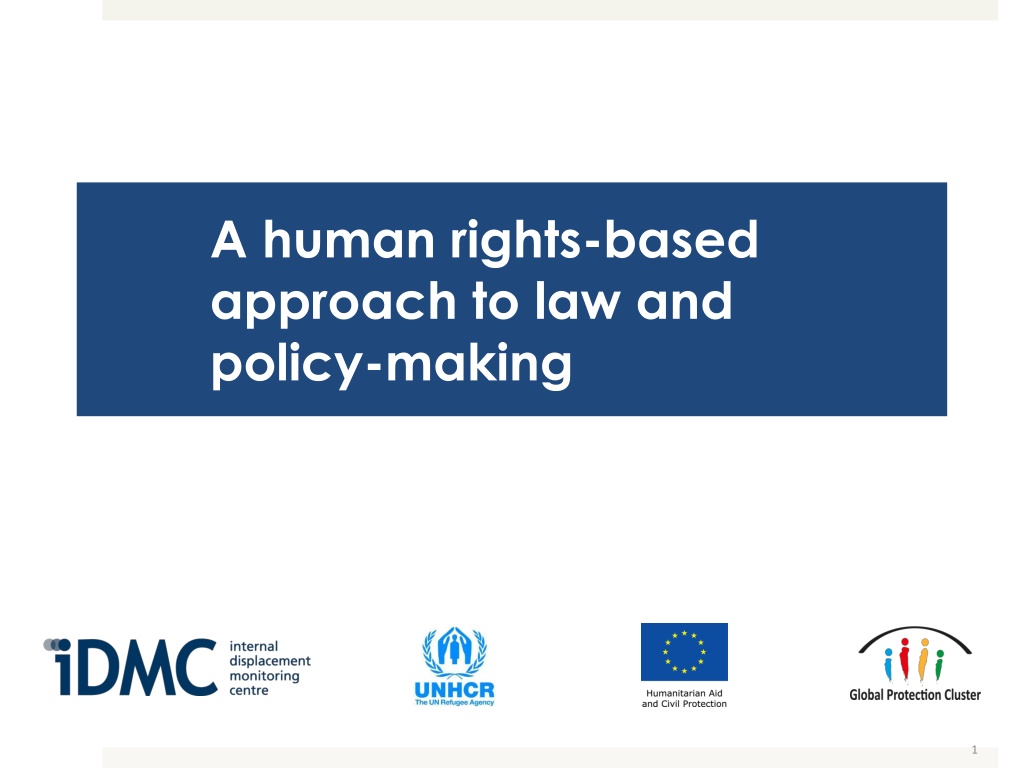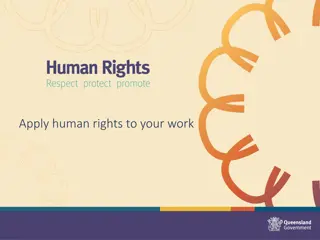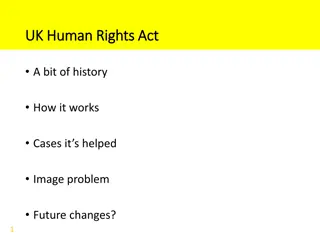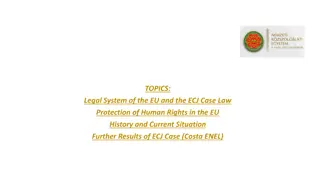Understanding a Human Rights-Based Approach to Law and Policy Making
This informative content discusses the importance of a human rights-based approach in law and policy making, particularly focusing on the protection and assistance of Internally Displaced Persons (IDPs). It explores international legal standards, the Guiding Principles, the Kampala Convention, and the prohibition of arbitrary displacement, emphasizing the legal obligations and rights associated with IDPs.
Download Presentation

Please find below an Image/Link to download the presentation.
The content on the website is provided AS IS for your information and personal use only. It may not be sold, licensed, or shared on other websites without obtaining consent from the author. Download presentation by click this link. If you encounter any issues during the download, it is possible that the publisher has removed the file from their server.
E N D
Presentation Transcript
A human rights-based approach to law and policy-making 1
Objectives To illustrate the bodies of international law relevant to IDPs protection and assistance To determine the legal obligations towards IDPs that derive from international instruments To present a human rights-based approach as the basis for law and policy development To identify IDPs rights during all phases of displacement 2
International legal standards International legal framework for IDPs Human rights IHL IDRL IHRL International criminal law 3
The Guiding Principles Adopted in 1998 by the UN human rights commission 30 principles restate international law All phases of displacement covered Provides a rights-based approach to IDPs protection and assistance Provides guidance to states and others Identifies relevant IHRL and IHL standards A practical tool 4
Kampala Convention: a comprehensive instrument The convention: Tackles all possible causes of displacement conflict, violence, disasters and development projects Addresses all phases of displacement prevention, protection during it and pursuit of durable solutions 5
What does the Kampala convention add? Legally binding It restates principles and provisions for IDPs protection and creates legal obligations for states and others Specific instrument It focuses on IDPs and people at risk of displacement Regional document It recognises and addresses the specifics and complexity of internal displacement in Africa Different roles Addresses the role of armed groups, non-state groups, CSOs, international organisations and private companies 6
Prohibition of arbitrary displacement Kampala Convention articles 1.a and 4.4: Right of all people to be protected against arbitrary displacement Arbitrary displacement Respect Protect Fulfil Refrain Prohibit Prevent Examples of prohibited displacement 6.2 Legality Legitimate aim Necessity IHRL IHL 7
Prevention Article 4.2: State responsibility to prevent and avoid conditions leading to displacement Conflict: Disasters: Protection of minority rights, rule of law, participation, adequate standard of living There is no such thing as a natural disaster, only natural hazards. UN office for DRR Prevention of IHL violations that trigger displacement Disaster management, mitigation and preparedness Dialogue with all parties, outreach to security forces, training Early warning systems Fight against impunity Model act on disaster relief and initial recovery assistance, 2013 Criminalisation of arbitrary displacement 8
IDPs protection: Articles 5.7 and 9 A. Civil and political rights related to people s lives, safety, physical wellbeing and family unity. B. Economic, social and cultural rights related to food, basic shelter, health and primary education D. Civil and political rights related to personal documentation, and freedom of movement, expression, opinion, religion and voting C. Economic, social and cultural rights related to housing, land and property (HLP), livelihoods, and secondary and higher education Source: UN secretary general s representative on IDPs human rights 9
Durable solutions: Articles 11 and 12 and the IASC framework Achieved when IDPs no longer have specific needs linked to their displacement and can enjoy their human rights without discrimination on account of their displacement . Establish IDPs right to a free and informed choice between: Sustainable reintegration in place of origin Sustainable local integration Sustainable integration in another part of the country Affirm the state s responsibility to establish the conditions for IDPs to achieve durable solutions 10
Criteria for durable solutions Accessible mechanism for restoration of HLP Long-term safety and security Adequate standard of living Personal and other documentation Access to livelihoods and employment Family reunification Access to remedies and justice Participation in public affairs Kenya s 2012 act on IDPs incorporates the eight criteria and adds the full restoration and enjoyment of freedom of movement 11
Regional standards African Charter on Human and People s Rights (ACHPR) ACHPR protocol on women s rights African Charter on the Rights and Welfare of the Child Pact on Security, Stability and Development in the Great Lakes Region (Great Lakes Pact) Protocol on IDPs protection and assistance Protocol on returnees property rights 12
Ratification and domestication Article 3.2.a : States Parties shall: Incorporate their obligations under this Convention into domestic law by enacting or amending relevant legislation on the protection of, and assistance to, internally displaced persons in conformity with their obligations under international law . Monist v dualist systems Two steps Internal procedure: before the state assumes its international obligations External procedure: consent to be bound by the other contracting parties 13
Conclusions International legal standards are benchmarks for states action. IHRL, IHL, IDRL and ICL are relevant to IDPs protection and assistance. Adhering to international standards is a general state responsibility. A human rights-based approach should guide policy-making processes. 14























